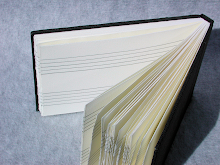 I differentiate books as journals being lined and sketchbooks being unlined. Using this terminology I think there are many sketchbooks that wish they were journals, but lineage was not available. Lined book blocks and paper are available, but that smart handmade paper that you really like is rarely going to be lined. For this reason I have been lining my own paper. I have the option to draw, print, or emboss the lines, and I can decide the color, gauge, and spacing of the lines.
I differentiate books as journals being lined and sketchbooks being unlined. Using this terminology I think there are many sketchbooks that wish they were journals, but lineage was not available. Lined book blocks and paper are available, but that smart handmade paper that you really like is rarely going to be lined. For this reason I have been lining my own paper. I have the option to draw, print, or emboss the lines, and I can decide the color, gauge, and spacing of the lines.Any printing method works. I have used etching, aquatint, and lithography. I haven't used screen printing or wood/lino cut. One of my favorite results was from a frame wrapped with mono filament fishing line. The fishing line leaves the printed line as well as a light score in the paper.
When drawing lines I set up a template with marks for line spacing. I place a rule at the appropriate mark and follow the straight edge very closely without touching the rule. This is my personal technique for making a very straight line that still has a looser hand drawn feel. I've also projected the lines with a digital projector and traced the lines.
 Whether drawing or printing I set up my template or printing plate so that the length of the paper is at least two signatures long. I make the lines on both sides of the paper then tear the sheet at signature length. Picture a toilet paper roll with lines running the length of the sheet and then tear off signatures as required. That is an exaggerated picture. Most of my prints and drawings tear down to give me two signatures. The matchbook size I get four to six signatures.
Whether drawing or printing I set up my template or printing plate so that the length of the paper is at least two signatures long. I make the lines on both sides of the paper then tear the sheet at signature length. Picture a toilet paper roll with lines running the length of the sheet and then tear off signatures as required. That is an exaggerated picture. Most of my prints and drawings tear down to give me two signatures. The matchbook size I get four to six signatures.
Sometimes when printing I'll get four signatures from one plate by drawing my plate so that the top and bottom of the plate are the tops of two signatures. The center line of the plate is the bottoms of the signatures. After printing both sides of the sheet, tear once length wise to get two double length signature sheets then tear those down to single signature length. Confusing description I'm sure. Using the image below. Picture it as two plates each large enough to make two signatures. The top plate is right side up and the bottom plate has the signature tops at the bottom. But instead of two separate plates make it one plate to print one large sheet that is then torn down to four pieces.
 Hmm, not sure if that's any better. Maybe there is still something usable here.
Hmm, not sure if that's any better. Maybe there is still something usable here.


No comments:
Post a Comment
Note: Only a member of this blog may post a comment.